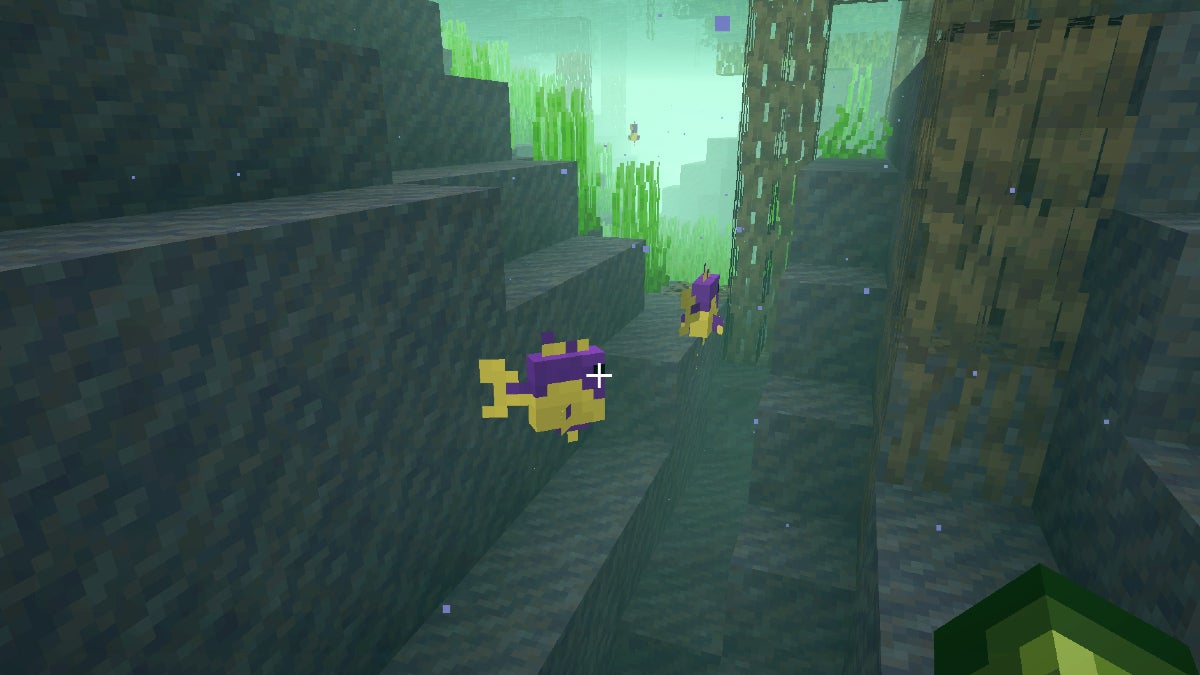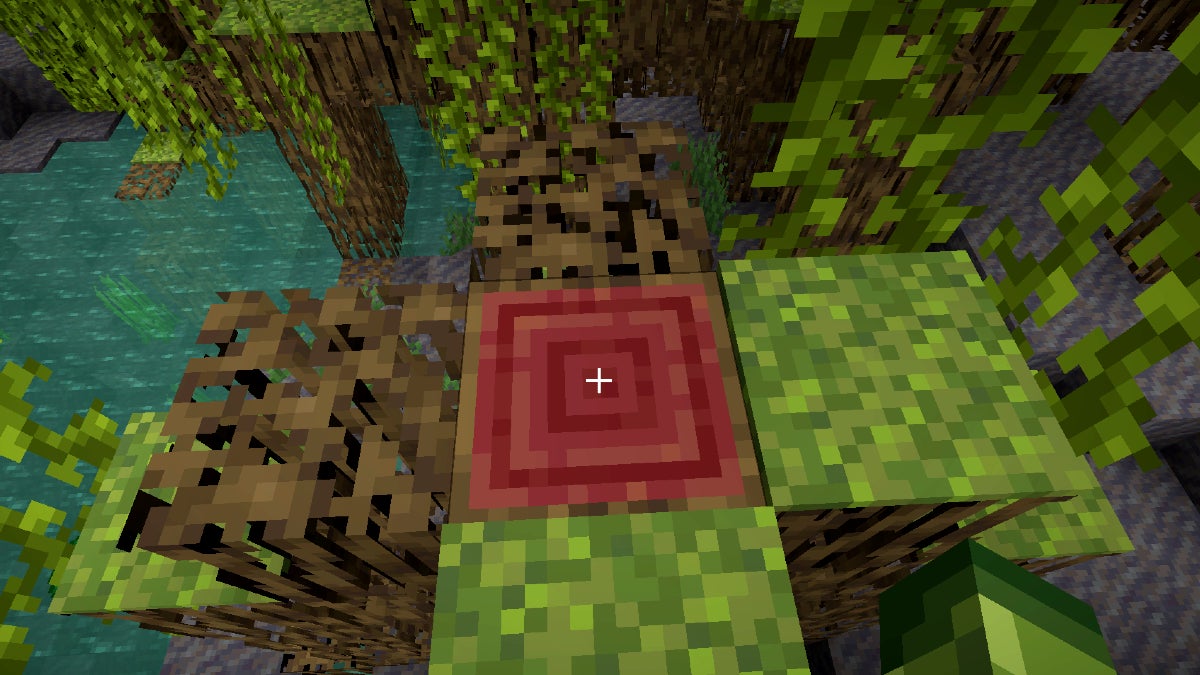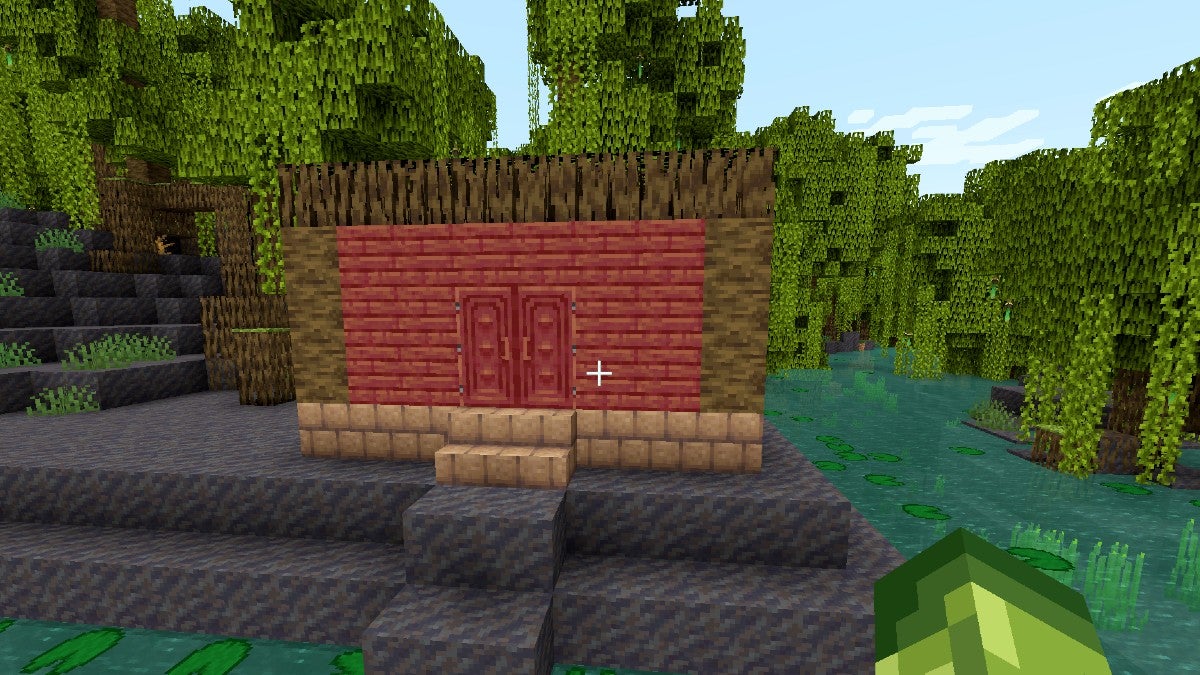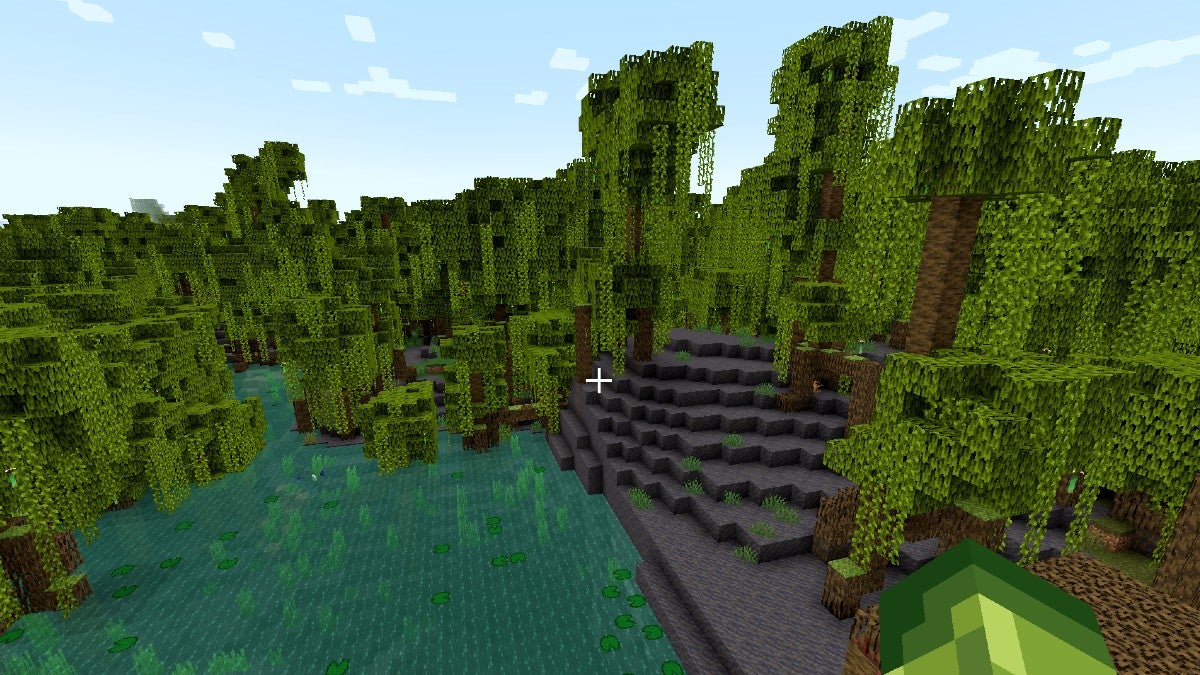![]() Key Takeaway
Key Takeaway
The most unique and usable features of a Mangrove Swamp are Mangrove trees and the resources they give you (mostly a new type of wood) as well as Mud, which you can use to make Packed Mud and Mud Bricks for decorative purposes. Additionally, Mangrove Swamps are one of the few places where you can naturally find Frogs.
As a variant of regular Swamp biomes, Mangrove Swamps have some similarities to their sister biome. However, there are many new features to check out in Mangrove Swamps. Get ready for muddy terrain and dense Minecraft foliage.
Table Of Contents
What You Can Find in a Mangrove Swamp

Mangrove Swamps are uncommon warm biomes with a resting temperature of 0.8 (the same as Swamps). Also like with common Swamps, the humidity here is 0.9 (in the Java Edition) and 0.5 (in the Bedrock Edition). This biome is most likely to spawn near other warm biomes, like Jungles and Deserts.
In terms of terrain, Mangrove Swamps have muddy ground and are densely packed with Mangrove trees. These traits can make traversing this biome slow. However, there is a lot to see here, so traveling at a more leisurely pace isn’t a bad thing in most cases.
Blocks Unique to Mangrove Swamps
- Mangrove Leaves
- Mangrove Log
- Muddy Mangrove Roots
- Mangrove Roots
- Mangrove Propagule
- Mud
Blocks Not Unique to Mangrove Swamps
- Fossil
- Vines
- Moss Carpet
- Bee Nest
- Grass Block
- Grass
- Dead Bush
- Lily Pad
- Seagrass
Mobs Found in the Java Edition
- Frog (White)
- Tropical Fish
- Glow Squid
- Bat
- Spider
- Zombie
- Zombie Villager
- Skeleton
- Creeper
- Slime
- Enderman
- Witch
- Spider Jockey
Mobs Found in the Bedrock Edition
- Frog (White)
- Tropical Fish
- Glow Squid
- Spider
- Zombie
- Zombie Villager
- Skeleton
- Creeper
- Slime
- Enderman
- Witch
- Spider Jockey
- Chicken Jockey
How You Can Use Unique Mangrove Swamp Blocks

The source of most of the new blocks in this biome is Mangrove trees—which are themselves quite unique. In the wild, you can find this species of tree growing on land as well as in the water.
Interestingly, their roots mostly appear above ground, allowing you to harvest them more easily. They also can prop up Mangrove trees so that they are almost floating in the air.
Leaves and Logs
These trees give you similar resources as other trees: leaf blocks, wooden logs, and saplings. Mangrove Leaves are relatively unremarkable, however, the Mangrove Logs gained from such trees are a rich reddish brown.
Their unique coloration makes them decent as a decorative building material. The Mangrove Planks made from Mangrove Logs have value for the same reason.
Growing Mangrove Trees from Mangrove Propagules
The saplings of a Mangrove tree are called Mangrove Propagules. They function much like other saplings, although have some unique traits. They need at least six blocks of space above them to grow. Furthermore, Mangrove Propagules can be planted on the following kinds of blocks:
- Dirt
- Grass Block
- Coarse Dirt
- Podzol
- Mycelium
- Rooted Dirt
- Moss Block
- Farmland
- Mud
- Clay
While you can plant a Mangrove Propagule onto a single block, it will also need terrain for its roots to spread. At the very least, you’ll need one non-Mud block on every side of the planted block for this kind of sapling to grow.
This is due to the height of Mangrove trees being directly connected to how far their roots can spread. Such roots can stretch up to five blocks away from the Mangrove Propagule.
What Mangrove Roots Do
Besides allowing Mangrove trees to suck up nutrients, Mangrove Roots and Muddy Mangrove Roots don’t have many potential functions.
Mangrove Roots can be waterlogged even though they are solid blocks. As such, you can use them to manipulate water. Additionally, Redstone signals can pass through Mangrove Roots to power devices nearby—even while waterlogged.
Muddy Mangrove Roots, on the other hand, can’t get waterlogged or let Redstone signals pass through them. As such, this latter type of root block is pretty boring besides having a unique texture.
How to Use Mud
Mud blocks act differently between the two versions of Minecraft. In the Java Edition, Mud is not a solid block. This means that mobs and players that walk over it will partially sink, although their movement speed will not be decreased.
Furthermore, blocks that can naturally fall, like Gravel, will turn into dropped versions of themselves when they land on Mud blocks. What’s more, Hoppers placed directly below Mud blocks can still suck in items from above them.
Conversely, in the Bedrock Edition, Mud acts like a solid block. This means that in this version of the game, Mud blocks will not cause those standing on them to sink. And, when placed above a Hopper, will block the device from sucking in items.
Although, in both versions of Minecraft, Mud can be turned into Clay. To do so, place a block on top of a Pointed Dripstone and then place a block of Mud on top of that block. Over time, the Mud will drip through the jagged stone and come out as a block of Clay beneath the Pointed Dripstone.
You can also make other blocks with Mud. If you combine a block of Mud with one piece of Wheat, you’ll get one block of Packed Mud. Packed Mud’s only use is to make Mud Bricks. To do so, on any kind of crafting grid, combine four Packed Mud blocks in a square formation to get four Mud Bricks. Mud Bricks are decorative blocks that you can use as an alternative to regular Bricks.
Should You Setup a Base in a Mangrove Swamp?

It may be tempting to build a house in a Mangrove Swamp due to them being a new biome (as of the 1.19 update). However, there are both some pros and cons you should consider before setting up a structure in this biome.
Pros of Building a Base in a Mangrove Swamp
This biome is full of building materials, so it will be easy to get the resources you need to create a house. Furthermore, you’ll have access to the beautifully colored Mangrove Logs and Mangrove Planks, which can make a lovely house.
Mud Bricks, while duller in color, have a defined texture that can make them look great as foundation blocks for a structure.
On top of that, there will be plenty of water nearby, which can be useful for many reasons. The presence of Bee Nests in this biome can also potentially let you set up a Honey farm.
Cons of Building a Base in a Mangrove Swamp
On the flip side of things, Mangrove Swamps can be dangerous. The large canopies of Mangrove trees create a lot of shade, which will protect undead mobs from the sun. Furthermore, such trees will make the area dark enough for hostile mobs to spawn during the day.
Although the presence of lots of water can be useful, it can also make traveling through such locations slow—unless you have a Boat.


